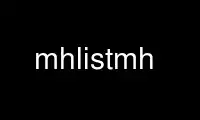
This is the command mhlistmh that can be run in the OnWorks free hosting provider using one of our multiple free online workstations such as Ubuntu Online, Fedora Online, Windows online emulator or MAC OS online emulator
PROGRAM:
NAME
mhlist - list information about MIME messages
SYNOPSIS
mhlist [+folder] [msgs] [-file file] [-part number] ... [-type content] ... [-headers |
-noheaders] [-realsize | -norealsize] [-rcache policy] [-wcache policy] [-check |
-nocheck] [-changecur | -nochangecur] [-verbose | -noverbose] [-disposition |
-nodisposition] [-version] [-help]
DESCRIPTION
The mhlist command allows you to list information (essentially a table of contents) about
the various parts of a collection of MIME (multi-media) messages.
mhlist manipulates MIME (multi-media messages) as specified in RFC 2045 to RFC 2049 (See
mhbuild(1)).
The -headers switch indicates that a one-line banner should be displayed above the
listing.
The -realsize switch tells mhlist to evaluate the “native” (decoded) format of each
content prior to listing. This provides an accurate count at the expense of a small
delay.
If the -verbose switch is present, then the listing will show any “extra” information that
is present in the message, such as comments in the “Content-Type” header.
If the -disposition switch is present, then the listing will show any relevant information
from the “Content-Disposition” header.
The option -file file directs mhlist to use the specified file as the source message,
rather than a message from a folder. If you specify this file as “-”, then mhlist will
accept the source message on the standard input. Note that the file, or input from
standard input should be a validly formatted message, just like any other nmh message. It
should NOT be in mail drop format (to convert a file in mail drop format to a folder of
nmh messages, see inc(1)).
By default, mhlist will list information about the entire message (all of its parts). By
using the -part and -type switches, you may limit the scope of this command to particular
subparts (of a multipart content) and/or particular content types.
A part specification consists of a series of numbers separated by dots. For example, in a
multipart content containing three parts, these would be named as 1, 2, and 3,
respectively. If part 2 was also a multipart content containing two parts, these would be
named as 2.1 and 2.2, respectively. Note that the -part switch is effective for only
messages containing a multipart content. If a message has some other kind of content, or
if the part is itself another multipart content, the -part switch will not prevent the
content from being acted upon.
A content specification consists of a content type and a subtype. The initial list of
“standard” content types and subtypes can be found in RFC 2046.
A list of commonly used contents is briefly reproduced here:
Type Subtypes
---- --------
text plain, enriched
multipart mixed, alternative, digest, parallel
message rfc822, partial, external-body
application octet-stream, postscript
image jpeg, gif, png
audio basic
video mpeg
A legal MIME message must contain a subtype specification.
To specify a content, regardless of its subtype, just use the name of the content, e.g.,
“audio”. To specify a specific subtype, separate the two with a slash, e.g.,
“audio/basic”. Note that regardless of the values given to the -type switch, a multipart
content (of any subtype listed above) is always acted upon. Further note that if the
-type switch is used, and it is desirable to act on a message/external-body content, then
the -type switch must be used twice: once for message/external-body and once for the
content externally referenced.
The parts of a multipart/alternative part are listed in the reverse order of their
placement in the message. The listing therefore is in decreasing order of preference, as
defined in RFC 1521.
Checking the Contents
The -check switch tells mhlist to check each content for an integrity checksum. If a
content has such a checksum (specified as a Content-MD5 header field), then mhlist will
attempt to verify the integrity of the content.
Use mhlistmh online using onworks.net services
